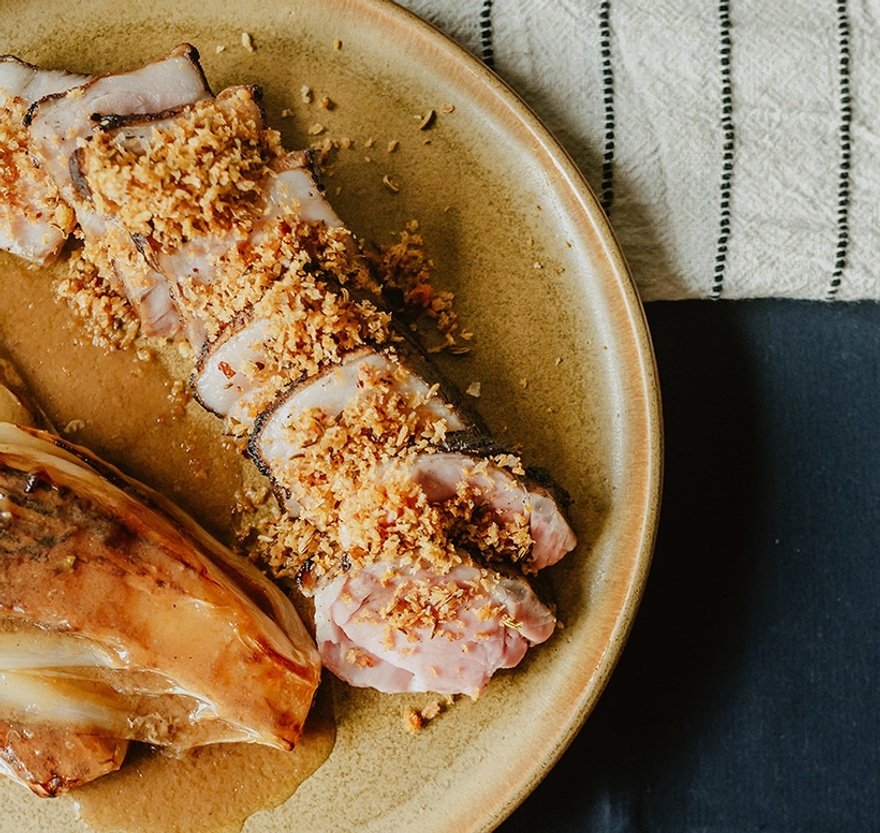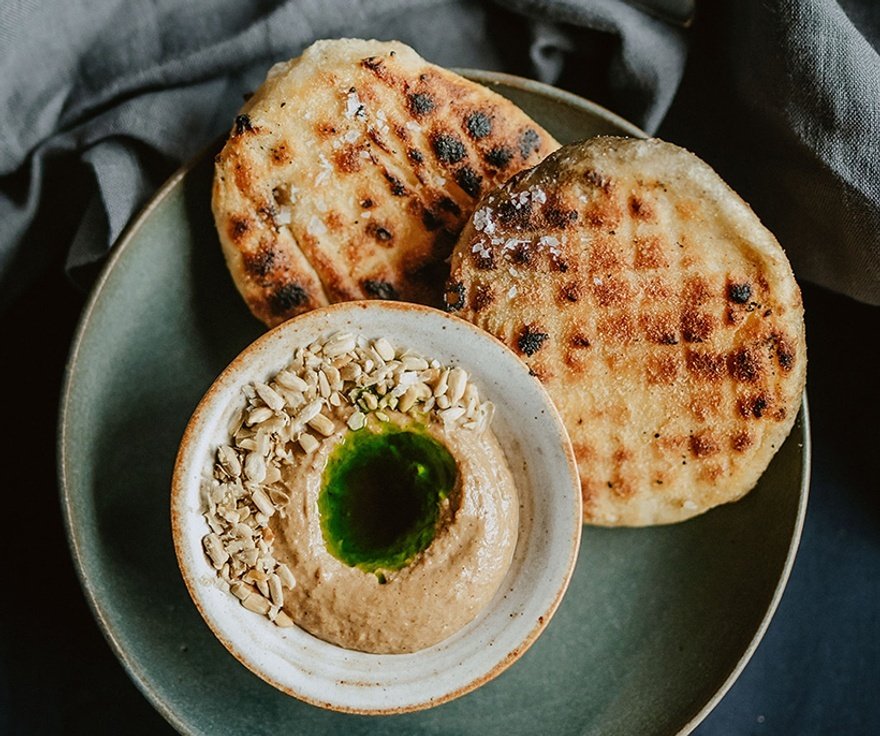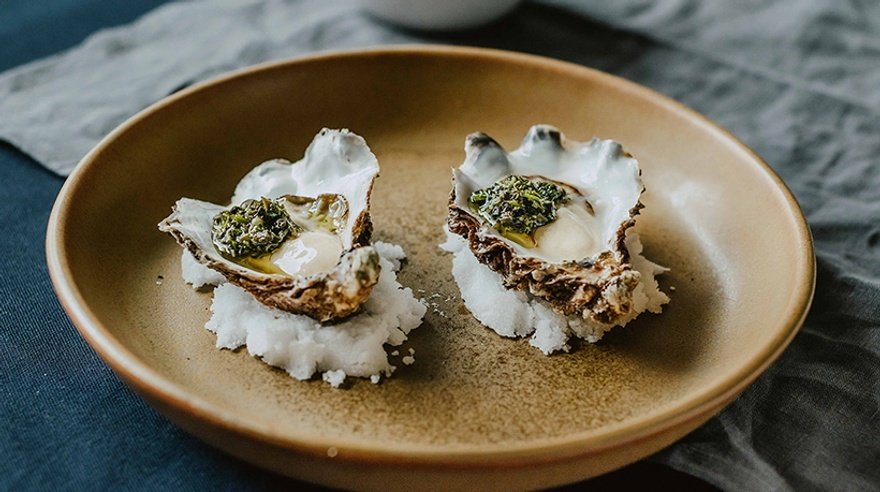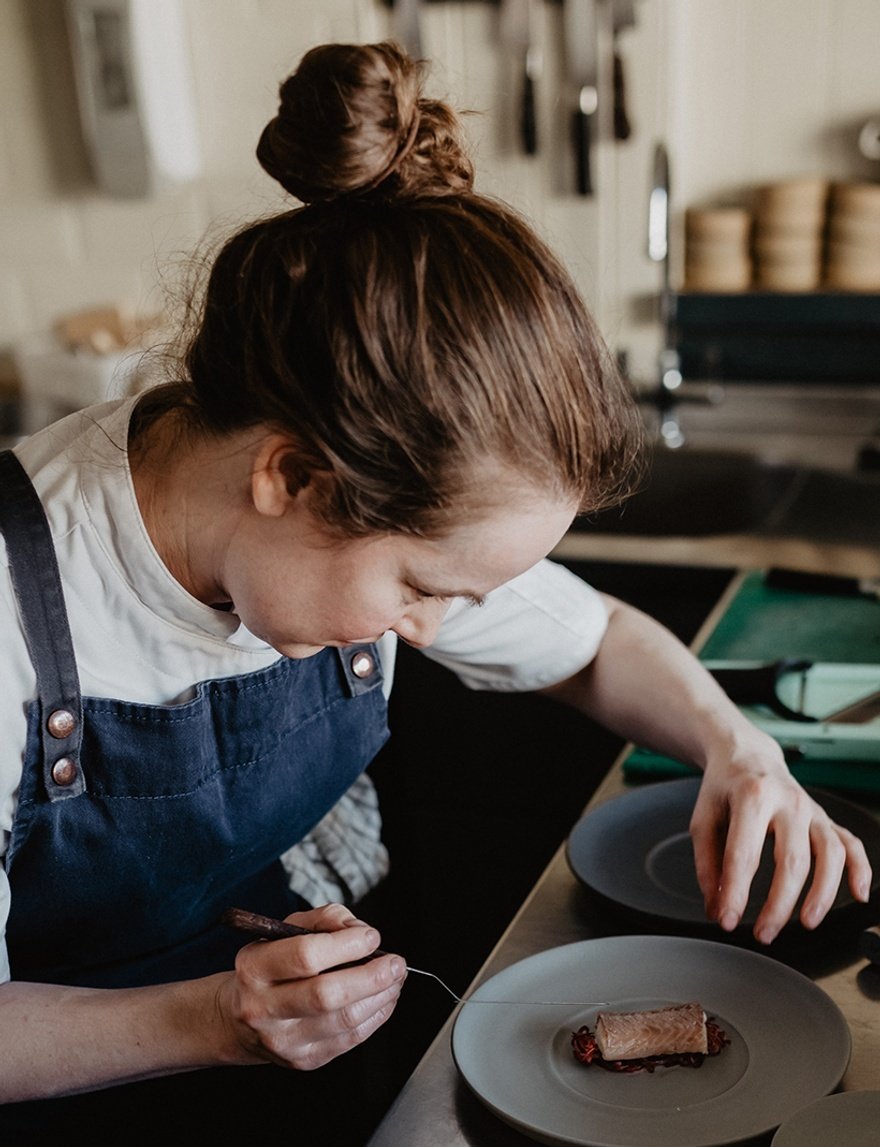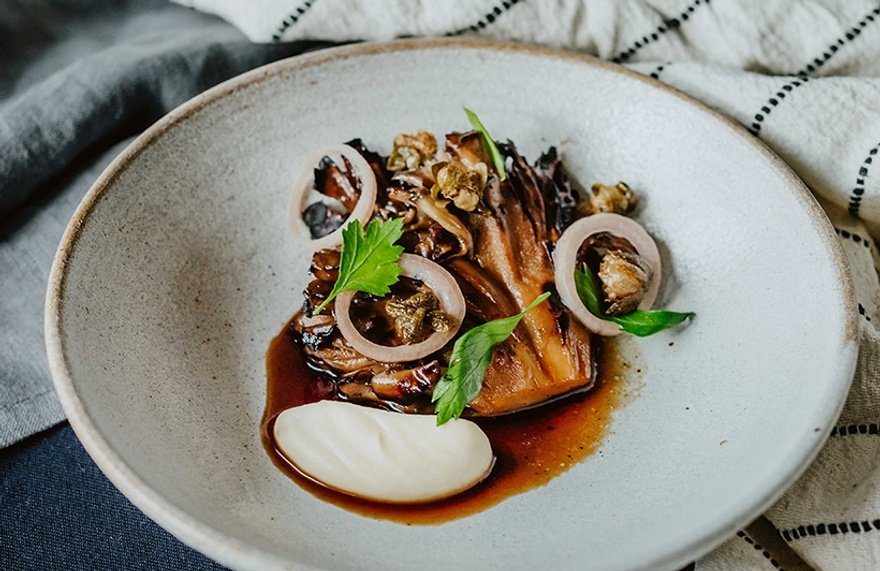Since 2018, the Little Chartroom in Edinburgh has built a loyal fanbase and won rave reviews from some of the country's toughest critics. Owners Roberta and Shaun Hall-McCarron are now moving their bijou restaurant to a bigger site – and launching a fresh concept in the old premises. Tom Vaughan reports
Roberta and Shaun Hall-McCarron are having a husband-and-wife moment. Shaun is explaining: "Roberta will make a new dish, and I'll ask ‘How much for this?' And she'll say, ‘Well, it should cost £38, but put it on for £32 – I don't want a main costing more than 32.' But if it's £38, it needs to be £38 on the menu!" says Shaun, smiling at his wife and business partner, who has heard enough.
"No!" she retorts, dragging the word out in her soft Edinburgh accent. "You balance your menu out so that you have dishes where you get your GP back!"
On reflection, the ‘what do you argue about?' question wasn't perhaps the best to throw at a couple who spend pretty much their whole waking life together. For the past three years, the pair have owned and run Edinburgh-based restaurant the Little Chartroom, where Roberta cooks and Shaun runs the front of house. To say they live in each other's pockets is an understatement – for a long while they constituted two-thirds of the business's entire workforce. Now, however, the Little Chartroom is, in their words, "growing up". The Hall-McCarrons are relocating it to larger premises and launching a new restaurant, Eleanore, at the old site.
We've never wanted any investors. We've never taken a loan. Our growth has been super-organic"
For a pair that have established themselves as popular fixtures on the Edinburgh dining scene, it's a big few months. Considering that their original business plan factored in the possibility of doing just three for lunch and six for dinner – "as a worst-case scenario!" clarifies Roberta – the fact that they can now countenance putting a dish on for £38 speaks to the journey the pair have been on and the big waves that the Little Chartroom has made.
Those unfamiliar with the Little Chartroom of old need to know that it really did put the emphasis on ‘little'. An 18-cover site with an open kitchen, where chefs also pitched in front-of-house, it was initially too small even to qualify for business rates. "You could barely get in between the tables," says Shaun.
Yet for them, the site was perfect. It was affordable (a vital factor, considering the couple have built their business without loans or investors, more of which later), manageable, and the ideal showroom for combining Roberta's seasonal cooking with Shaun's personal approach to service.
Slowly, the rave reviews began to trickle in from the likes of The Guardian's Grace Dent ("unique, delicious, risky and completely remarkable"), The Sunday Times's Marina O'Loughlin ("divine") and The Financial Times's Tim Hayward ("It began to dawn on me that this was the work of a significant and important cook. The subtlety, the cleverness, the profound feeling for ingredients.")
Rooms to breathe
"The response to the original Little Chartroom was more than we could have ever hoped for," Roberta recalls. "And as the team grew and became more ambitious and wanted more equipment, we were bursting at the seams."
On the back of the Chartroom's success, the pair took the decision post-lockdown to relocate to a larger site, a mile further into Leith, and the new-look restaurant officially opened its doors in September. While cover numbers have hardly rocketed (28, as opposed to 18), the pair are nevertheless excited about the potential of the larger space.
"It's the simple things," Roberta says. "In the old restaurant, I could never do a hot dessert because we could only have one person cooking at any one time. Or I could never do anything that was steamed because it didn't have a steamer. We already have a sweetcorn steamed custard on the menu as a savoury starter. And I think it is everyone's favourite dish so far."
With the new site, a larger team (there's now nine spread across kitchen and front of house) and a burgeoning reputation, Roberta admits her cooking has evolved. The original Chartroom started out very much as a bistro concept, mainly because the couple felt that was what the city most needed.
"It was a bit of a gap in the market," Roberta explains. She has slowly begun to move closer to her fine-dining roots.
"Originally, we thought we can never put certain ingredients on because it's too expensive and people will frown and won't come," she says. "So it feels almost like a sense of achievement to be able to put on these slightly more premium products."
I think [Eleanore is] something a little bit different
Although the food may have taken a step towards a £38 main, the DNA of the Little Chartroom will remain in place, including a stripped-back, personal approach to service, and a fluidity between front and back of house that sees all staff wear the same aproned uniforms and pitch in with service.
"We've got a few new people who have just started, and last night they were a bit surprised when I called them to clear the starters and set up the mains," Shaun says. "They were in between service at the time. Why should front-of-house staff run about like daft flies when we've got all these skilled people who are free and can help? And the guests love seeing the chefs doing that."
The couple hope the average spend at the new Chartroom will be between £80 and £100 per head – a price point that still falls way short of the city's powerhouse fine-diners, but still sits at the top end of brasserie dining.
Filling that gap in the market for bistro prices, they hope, will be new restaurant Eleanore. It's their second restaurant and a concept that was born from a "very positive" lockdown experience, even if it didn't seem that way during the first weeks. At the start of 2020, the couple were close to signing the lease on a site, but had no fixed plan of what to do with it. As the pandemic unfolded, the couple pulled the plug, finding themselves sitting at home, twiddling their thumbs with no immediate means of income.
"We have never wanted any investors or backing. We've never taken a loan. Our growth has been super-organic," Roberta says. "So it was heartbreaking at the start of lockdown that all this money we saved up to push ourselves forward and invest in something else was potentially going to fizzle away."
Second site
As fate would have it, Roberta's debut on the BBC's Great British Menu coincided with lockdown, when the nation was stuck at home watching TV, and the Little Chartroom began picking up valuable PR at a time when it wasn't even open. The couple capitalised on the attention by selling takeaway meals, which flew out the door. Then, when an opportunity arose to take residency in a street-food booth on nearby Portobello Beach, they leapt at it, naming it the Little Chartroom on the Prom.
Not only did it provide another Covid-proof revenue stream, but – thanks to the upmarket barbecue takeout dishes conjured up by Chartroom chefs Hamish McNeil and his friend Moray Lamb – a vision of what a second bricks-and-mortar site might look like. The result is Eleanore, which will launch in December on the site vacated by Chartroom.
"I think it's something a little bit different," says Shaun. "There are wine bars in Edinburgh serving food, but it has always sort of been an afterthought to the wine. Here, it'll be as important – with as much barbecue cooking as our extraction will allow. We want people to walk past, spot a spare table, and either come in for some oysters and a quick glass of wine, or order 12 items off the menu and spend three hours."
Self-starters
All of this has been funded entirely by the couple – a philosophy that is sacrosanct. "When bounce-back loans were available coming out of lockdown, I said ‘Why don't we take one out?'" recalls Shaun. "Roberta said, ‘Absolutely not. We built our business on never taking out a loan. If we buy something, it's because we have the money to do it, and we have to work for that.'"
All the attention around the two launches is a deserved triumph for a couple who have assiduously worked their way through the industry, learning their craft, saving for their own places, never biting off more than they can chew. For Roberta, it is a career that has taken her from local restaurants to the Burj Al Arab Jumeirah in Dubai, then back to the Kitchin in Edinburgh. "The first time I worked under somebody who was a chef-owner, he was just so, so driven, so passionate, I learned so much," she recalls.
She stayed at the Kitchin for three and a half years, before opening sister restaurant Castle Terrace with chef Dominic Jack, rising to head chef during the course of a six-year stint.
It was there she met Shaun, who – after a year as a trainee manager at Dakota Hotels – was experiencing a fine-dining restaurant for the first time. Overcoming some initial teething problems ("Roberta will vouch for this – she hated me at first because I was useless!"), he rose to assistant manager before moving to London for stints at both the Square and Roganic. It was the latter that inspired his approach to service. "They had amazing food, amazing wines, so much attention to detail, but none of the fuss," he says. "Everything was stripped back and it was just about being on a super-personal level with the guests."
Returning to Castle Terrace as restaurant manager, he and Roberta (they were by now a couple) decided to taste life running a business by taking on a pub with rooms in Cambridgeshire. "It was an amazing gastropub, but ultimately it was an efficient business that had a regular clientele who liked Scotch eggs and sandwiches. If we had just torn that up, we probably would have run the business into the ground."
The upside was that the owners remunerated them generously, and those savings went into the Little Chartroom, which opened its doors in June 2018. Having hit on a winning formula (there are, for example, no tables for two available at Chartroom until April), do they have ambitions for future sites?
They look at each other and shake their heads. "If we do anything, it would be to make Eleanore bigger. It'd be nice to buy the hairdressers next door," Roberta says.
It says everything about the couple's approach to business that Shaun follows up with their ultimate ambition: to make their two restaurants as robust, durable and future-proofed as possible.
"I suppose the longest-term goal is to own the actual buildings," he says. "That would be the dream. Rather than just keep growing and keep growing, to consolidate."
Roberta nods along. "We just want to keep investing in the businesses. We want them to be the best that they can be."
Contact and details
The Little Chartroom, 14 Bonnington Road, Edinburgh EH6 5JD
Opened 18 September 2021 Covers 28 Staff 9 Dishes Sweetcorn custard, XO, baby leeks, black garlic (£12.50); lemon sole, mussels, elderberry, potato, cabbage (£32); damson ice-cream sandwich, pistachio (£9.50)
Eleanore, 30-31 Albert Place, Edinburgh EH7 5HN
Opening December 2021 Covers 20 Staff 2 Dishes BBQ pork neck, chicory and quince; flatbread with sunflower-seed dip; oysters with fermented cucumber, sweet pickled apple and horseradish oil
Dressed crab, curry, cucumber, smoked almonds (the Little Chartroom)
Serves 4
For the cucumber dressing
- 2 Granny Smith apples
- ½ cucumber
- 40ml white balsamic vinegar
- Fine salt, pinch
For the curry oil
- 200ml of sunflower oil
- 50g of thinly sliced Granny Smith apple
- Third of a sliced white onion
- ½ stalk lemongrass, thinly sliced
- 2tbs Madras curry powder
- 1 makrut lime leaf
For the curry mayo
- 2 egg yolks
- 1tsp Dijon mustard
- 300ml curry oil
- 2tsp lime juice
- 40ml yogurt
For the rice crackers
- 105g sushi rice
- 450ml water
- 5g salt
- 1 litre sunflower oil
To finish
- 300g picked white crab meat
- 80g smoked almonds, chopped small
- ½ cucumber, halved and sliced thin
- 2 finger limes cut open and scooped out, or 1 lime
- 1tsp Korean chilli powder
For the cucumber dressing, cut the apple into small pieces, removing the core. Cut the cucumber into small pieces, place in a blender and blend until smooth, and add in the salt and vinegar. Strain through a piece of muslin or cloth.
For the curry oil, heat a cup of oil in a medium saucepan over a low heat. Add the apple, onion and lemongrass, sweating until translucent (approximately five minutes). Add the curry powder and cook out for a further two to three minutes. Add the remaining oil and the makrut lime leaf, and heat the oil to 70°C. Remove from heat, cover and steep for 20 minutes, strain through a coffee filter.
For the curry mayo, whisk together the egg yolk, mustard and lime juice. Slowly start adding the curry oil, whisking constantly to emulsify. Finish by adding fine salt, and fold the yogurt through the mayo.
For the rice crackers, boil the rice in the water until slightly overcooked, whisking occasionally to break down the grains. Place in a blender and blend until smooth. Divide the mixture into two and spread flat onto a piece of parchment paper on a tray. Place in an oven at 70°C for approximately five hours, until the rice mixture has dried and you can snap it into smaller pieces. If it bends, it needs longer to dry out.
Pour a litre of oil into a medium-sized pot and heat on the stove to 210°C. Once it has reached temperature, using tongs, carefully place the dried rice crackers into the oil, one at a time; they will double in size and puff up.
To finish, place the crab meat in a bowl and add two heaped tablespoons of curry mayo, and mix well. Using the finest part of a grater, grate the lime zest into the crab, mix it in and season. Divide the crab mixture into four and spoon each portion into a 14cm-diameter bowl, spreading it evenly over the base.
Dress the cucumber slices with the cucumber and apple dressing, and place flat over the crab. Sprinkle the chopped almonds on top, then a small amount of the Korean chilli flakes. Last, spoon the finger limes evenly over everything or squeeze a little lime juice on top if you were unable to get finger limes. Serve the puffed rice crackers alongside.
Hen of the Woods, shiitake Bordelaise, celeriac (Eleanore)
Serves 2
- 100ml water
- 100ml rice wine vinegar
- 100g caster sugar
- 100g kecap manis
- 50ml soy sauce
- 30g dried shiitakes
- 1 celeriac, peeled and thinly sliced
- 750ml milk
- 300ml double cream
- 40g butter
- 10g white miso
- 100ml vegetable oil
- 25g lilliput capers
- 300ml veal stock
- 750ml red wine
- 100g shallots, peeled and sliced
- 200g Hen of the Woods mushrooms, cleaned and cut into generous ‘steaks'
For the shiitake pickle liquor, heat together the water, vinegar, sugar, soy and kecap manis. Bring to a boil to dissolve the sugar and pour over the shiitake. Leave to hydrate for at least an hour, and ideally overnight. Strain the shiitake, reserving the mushrooms for finishing the sauce. Pour the liquor into medium vacpack bags, along with the Hen of the Woods, and compress on full pressure.
For the celeriac purée, cover the celeriac with the milk and cream, season lightly with fine salt and bring to the boil. Turn down the heat and simmer until the celeriac is completely soft. Strain, reserving the milk/cream mixture. Place the celeriac, butter and miso in a blender and blend on high speed until completely smooth, adding any reserved milk/cream mixture to achieve a thick purée.
For the crispy capers, heat the vegetable oil to 180°C, add the capers and deep-fry until crisp. Drain on kitchen paper and reserve.
For the Bordelaise sauce, sweat the shallots in a heavy-base saucepan. Pour in a third of the red wine and allow to reduce to a syrup. Repeat this process twice more. After the final reduction, add the veal stock and reduce to a thick sauce consistency.
To serve, drain the Hen of the Woods and use the shiitake pickle liquor to season the Bordelaise sauce. Grill the Hen of the Woods over hot coals until lightly charred and smoky. Warm the celeriac purée and place a large spoonful in a bowl. Place the grilled Hen of the Woods next to the purée. Reheat the Bordelaise sauce and pour over. Finish with diced pickled shiitake. Cover with crispy capers, parsley and shallot rings.
Continue reading
You need to be a premium member to view this. Subscribe from just 99p per week.
Already subscribed? Log In


